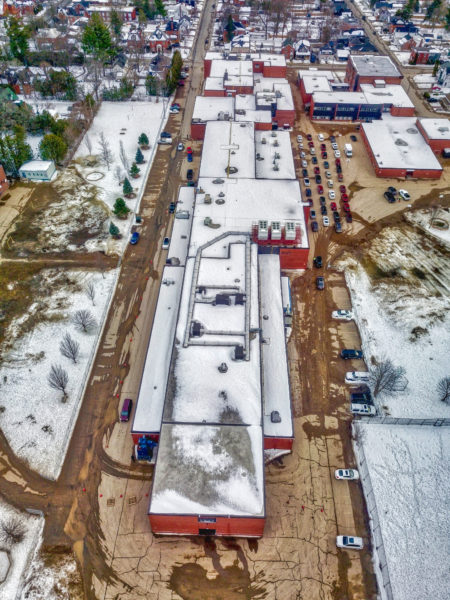TORONTO, March 22, 2021 – As cities and towns across Canada and the United States grapple with the logistics of planning COVID-19 vaccine sites, York University professors have been busy helping to plan mass vaccinations using different methods, including drive-through vaccination centres.
The vaccination drive-through simulation, which has now helped organizations in both countries to plan how to get as many people vaccinated as possible, was developed by Faculty of Liberal Arts & Professional Studies Associate Professor Ali Asgary, associate director of the Advanced Disaster, Emergency and Rapid Response Simulation (ADERSIM) in collaboration with the Laboratory for Industrial and Applied Mathematics (LIAM), led by Professor Jianhong Wu of the Faculty of Science.
The simulation has been listed as one of the best community models on the AnyLogic software website and the peer-reviewed paper has been downloaded around 5,000 times so far.

DCIM100MEDIADJI_0059.JPG
“The development of simulation tools that enable planning and preparation are essential for the success of timely and efficient vaccine dispensing,” says Asgary. “Planning and operation of drive-through clinics for mass vaccination requires extraordinary advance planning and preparation at the local, national, and international levels. Health agencies are looking for tools that will help them with these planning and operation complexities.”
Asgary worked with Jeff Dodge, advanced care and community paramedic A/commander for the County of Renfrew Paramedic Service, to plan three vaccination drive-through clinics for frontline healthcare workers in Renfrew, Ontario, with the Arnprior & District Family Health Team this month.
“Efficiency is everything. This model allows us to predict how many people we can vaccinate in an hour,” says Dodge, who has used it to run three drive-through vaccination clinics for healthcare workers in the local Arnprior District High School parking lot. “We started with 50 vehicles per hour at the first clinic and are now up to about 84 an hour and there is still room to go up a bit more.”
Each vehicle was registered in 45 seconds, plus another 60 seconds for the needle in the arm, followed by a 15-minute observation period. At their last clinic, they vaccinated 265 people in two hours and more clinics are on the way.
The trick he says is to make sure the line up doesn’t block the adjacent highway, but the model factors that in. He’s now using the simulation tool to evaluate additional sites for drive-through vaccination clinics for the public. “I’ve been using this model a lot. It’s really practical for planning, as well as ruling future sites in or out. I don’t know why everyone isn’t using it.”
Video clip of vaccination clinic at Arnprior District High School in Renfrew, Ontario by Scott McLeod, County of Renfrew Paramedic RPAS Program
UCHealth, a non-profit health system based in Colorado with multiple hospitals and clinics, also reached out to Asgary when they were planning a mass vaccination drive-through with their partners and collaborators. The result is that they were able to vaccinate 10,000 people in one weekend or 12 hours. That worked out to 834 cars per hour and 22.4 minutes per car, including a 15-minute observation period.
They point to the customizable drive-through vaccination model and simulation tool, developed by Asgary, which they used to help with the planning, including the number of cars and people entering, as well as the average time spent in the drive-through.
“Dr. Asgary's simulation enabled us to predict bottlenecks and snags in our flow based on the complex and interdependent interactions at each step in the process. Ultimately, simulation identified a major, previously unforeseen design flaw in our anticipated model, leading to substantial change and likely averting catastrophe. Thanks to our close collaboration, we were able to pull off the most efficient mass vaccination to date,” says Dr. Daniel Resnick-Ault of University of Colorado’s Department of Emergency Medicine, one of the medical directors for the mass vaccination clinic.
The team is currently working with Cook County Health and other stakeholders to simulate and research their drive-through facility at the United Centre in planning and preparation for operation.
These are just two examples of how the York simulation tool is being used and modified depending on the specific parameters and goals of each organization.
“Vaccinating everyone is one of the biggest public health challenges this decade,” says Asgary. “The advantages of a drive-through clinic are many, including a low risk for disease transmission for staff and public, a large number of people can be vaccinated, and it is useful for a geographically scattered population.”
-30-
York University is a modern, multi-campus, urban university located in Toronto, Ontario. Backed by a diverse group of students, faculty, staff, alumni and partners, we bring a uniquely global perspective to help solve societal challenges, drive positive change and prepare our students for success. York's fully bilingual Glendon Campus is home to Southern Ontario's Centre of Excellence for French Language and Bilingual Postsecondary Education. York’s campuses in Costa Rica and India offer students exceptional transnational learning opportunities and innovative programs. Together, we can make things right for our communities, our planet, and our future.
Media Contact:
Sandra McLean, York University Media Relations, 416-272-6317, sandramc@yorku.ca

